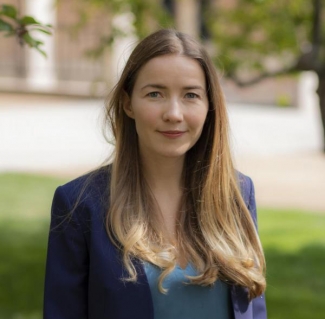JILA Fellow Ann-Marie Madigan was named a 2018 Packard Fellow. Below is a reposting of the CU Boulder Today's article that celebrates her acheivement:
A CU Boulder researcher who investigates the unusual behavior of icy objects at the outermost edges of the solar system has been named a 2018 Packard Fellow.
Ann-Marie Madigan is one of 18 scientists and engineers receiving this honor, which is handed out annually by the David and Lucile Packard Foundation. The award comes with a no-strings-attached, 5-year grant of $875,000 to support “the blue-sky thinking” of researchers across the country.
Madigan, an assistant professor in the Department of Astrophysics and Planetary Sciences (APS) and an associate fellow of JILA, said that she will use the award to explore the motion of “trans-Neptunian objects”—icy bodies that orbit the sun billions of miles from Earth.
In particular, she plans to dig into an improbable-sounding space mystery: Did jostling and crashing among these comets help lead to the extinction of the dinosaurs?
“These bodies can be small, but there are so many of them that, collectively, they can change each other’s orbits and send comets shooting into the inner solar system and where they can potentially smash into Earth,” Madigan said. “It’s about time that we begin to understand what that collective gravity does.”
“Professor Madigan is a creative and nimble theoretical astrophysicist,” said Nils Halverson, chair of APS. “With her Packard Fellowship, she will apply her theoretical tools to understanding orbital dynamics in our own solar system, possibly yielding insight into what caused the mass extinction of the dinosaurs. I’m proud to have her as a faculty member in our department and excited to support her work.”
Now in their 30th year, the Packard Fellowships for Science and Engineering seek to promote research that “over time will lead to new discoveries that improve people’s lives and enhance our understanding of the universe.”
Madigan is the 16th Packard Fellow to hail from CU Boulder. Christoph Keplinger, an assistant professor in the Department of Mechanical Engineering, was named a fellow in 2017 for his innovations in building soft machines.
“JILA is delighted that Ann-Marie’s past accomplishments and future success are being recognized with a Packard Fellowship to study the collective gravity of comets,” said Tom Perkins, chair of JILA, a joint institute of CU Boulder and the National Institute for Standards and Technology (NIST).
Collective gravity
Madigan received a Master’s and Ph.D. degree in astronomy from Leiden University in the Netherlands. She was a postdoctoral fellow at the University of California, Berkeley before joining the CU Boulder faculty in 2016.
Madigan’s research focuses on astronomical objects with “eccentric” orbits, or that move around in space like a stretched-out rubber band. More recently, the scientist—who became interested in astrophysics after reading about Einstein’s theory of relativity in a biography on her parents’ bookshelf—has set her sights on the solar system beyond Neptune’s orbit.
She said that, despite being relatively close to Earth, this stretch of space isn’t well understood by scientists. “We have more comets and asteroids in our solar system than we have stars in our galaxy,” Madigan said. “But they’re so dark and so hard to see that we don’t understand what large-scale structures they form.”
With funding from the Packard Foundation, Madigan is hoping to better understand those dark objects. In a series of recent studies, she has argued that, like a game of space billiards, these trillions of icy bodies exert a gravitational pull on each other—potentially nudging comets or minor planets into strange orbits.
Such “collective gravity” may also create regular cycles in which comets move closer to or farther away from Earth. That, in turn, may cause space debris to pummel the planet at predictable intervals, including around 65 million years ago when the Triceratops met its end.
“We’re trying to connect that impact event with what is going on in the broader solar system,” Madigan said. “In that way, the collective gravity of trillions of comets could play a role.”
Or, as Madigan put it, you’ll never know if you don’t look.




